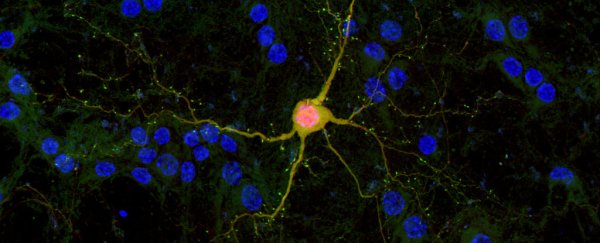Using a purely chemical method, two independent teams of Chinese researchers have successfully transformed skin cells into functional neurons, one working with Alzheimer's patients, and the other with cells extracted from mice.
The secret is a complex formulation of small molecules that alter the gene expression of the skin cells, and it's hoped that the technique could be used to grow new neurons to replace the defective ones in the brains of Alzheimer's patients. For example, scientists could extract skin cells, turn them into neurons, and transplant them into a patient's brain with a low risk of rejection.
The process of converting one type of cell into another is about as complicated as it sounds. One of the main challenges is that you might end up with cells that look like they have successfully been transformed, but they won't quite act the same as their natural counterparts.
This is what scientists from Stanford University in the US were faced with back in 2010 when they were the first in the world to convert skin cells into functional neurons. Instead of using a chemical method, they inserted genes into the skin cells that encode three types of transcription factors - proteins that help regulate gene activity by turning specific genes on and off.
But not only is this process incredibly complex and difficult to perform, there's no guarantee that the transcription factors will behave as expected, and that comes with a whole lot of safety concerns that have been holding the process back from real medical applications. Now, the two teams in China say their chemical method is simpler, and more reliable, which will hopefully make it a more viable option for future treatments.
"In comparison with using transgenic reprogramming factors, the small molecules that are used in this chemical approach are cell permeable; cost-effective; and easy to synthesise, preserve, and standardise; and their effects can be reversible," mouse study co-author, Hongkui Deng of the Peking University Stem Cell Research Centre, said in press release.
"In addition," he says, "the use of small molecules can be fine-tuned by adjusting their concentrations and duration, and the approach bypasses the technical challenges and safety concerns of genetic manipulations, which may be promising in their future applications."
Both the human and mouse cell teams confirm in separate Cell Stem Cell papers (here and here) that their transformed skin cells showed similar gene expression, behaviour, and synapse formation as those transformed via the transcription factor method. They both used a concoction of seven small molecules to achieve the cell transformation, but applying a different recipe to get a similar result.
According to the press release, the mouse cell team screened a number of different chemicals until they identified the key ingredient, I-BET151, which works to suppress transcription in skin cells. By figuring out which molecules to pair I-BET151 with, they ensured that the neurons could mature beyond transformation.
"By coordinating multiple signalling pathways, these small molecules modulate neuronal transcription factor gene expression and thereby promote the neuronal cell transition," says Jian Zhao from the Shanghai Institutes for Biological Sciences and Tongji University, who worked with the human cells.
The method is still in the 'proof-of-concept' phase, but both teams are encouraged by the results, and say if they can better understand how the chemicals they've been using work, this could be the beginning of a new type of treatment for mental degeneration. As Zhao mentions below, one possibility is formulating a "chemical cocktail" that can be given to an Alzheimer's patient to grow new neurons directly in their body, rather than from extracted cells.
"It should be possible to generate different subtypes of neurons with a similar chemical approach, but using slightly modified chemical cocktails," says Zhao. "It also needs to be explored whether functional neurons could be induced by chemical cocktails in living organisms with neurological diseases or injury."
As Annalee Newitz says at Gizmodo, "Imagine growing neurons right on your arm, then transplanting them into your brain or spinal cord to heal an injury." Bring it on.
